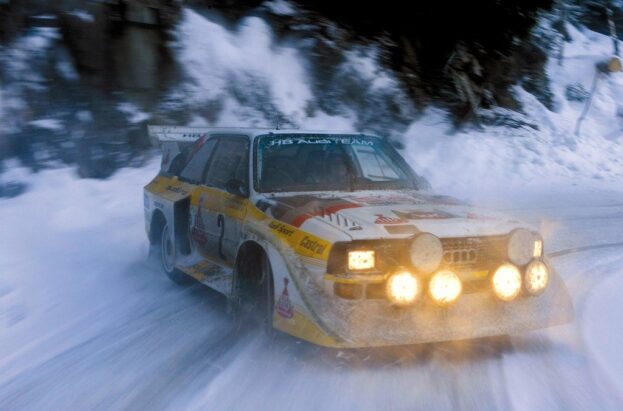
Rally racing can effectively be divided into two eras, before Quattro and after Quattro. Audi fan or not, one cannot deny the significance of the manufacturer’s introduction of all-wheel-drive to the world of motorsport
Rallying over the past 30 years would’ve been something completely different if an Audi chassis engineer hadn’t looked on in awe as his company’s version of the military Jeep, the four-wheel-drive Iltis, decimated every two-wheel-drive vehicle it came up against in the snow
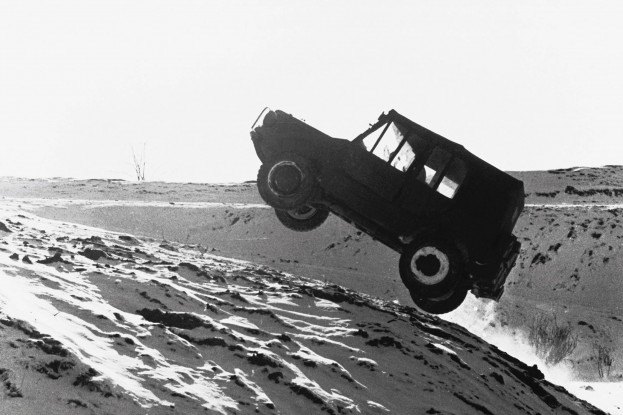
That was 1977. In 1979 European motorsport governing body FISA (now the FIA) legalized all-wheel-drive for rallying. Most of the works rally manufacturers at the time considered all-wheel-drive too heavy for racing, it was for Jeeps and the like, ungainly cars that guns were intended to be mounted on. Audi, whose front-wheel-drive 80 rally program wasn’t exactly burning up the stages, didn’t see it that way. Motivated by that chance encounter with an Iltis, they began experimenting with all-wheel-drive immediately. Audi unveiled their first all-wheel-drive production car, a turbocharged coupe they called “Quattro” in 1980. That same year veteran rally driver Hannu Mikkola used a Quattro rally car as a course opener and set a pace nine minutes faster than any of the rally’s official entries. All-wheel-drive was beginning to look damn promising. Correspondingly, Audi announced that they’d use the 1980 and 1981 rally seasons for development
Later in 1980, Hannu Mikkola slid a Quattro rally car to victory in its first event, the Austrian Janner Rally. Encouraging, but the car wasn’t quite the contender it was destined to be: the performance was there but reliability wasn’t. It took a little time for Audi engineers to properly sort the Quattro rally car
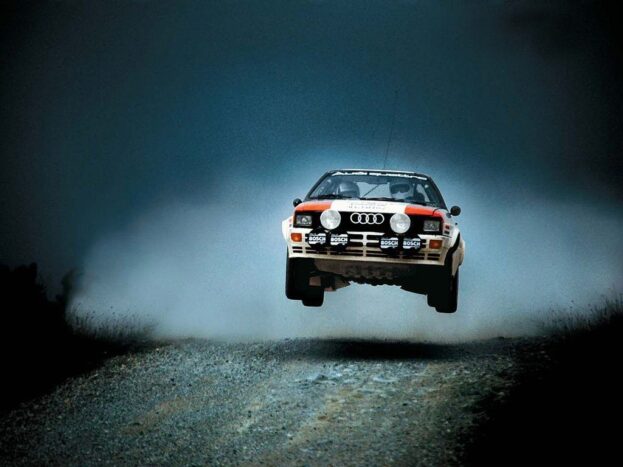
was 1982 when Audi pried open the eyes of the motorsport world to the massive potential of the all-wheel-drive platform. That year the Quattro pulled victory after victory in the World Rally Championship. Audi won the 1982 manufacturer’s title and only narrowly missed the driver’s title. The next year wasn’t as encouraging; Lancia finally replaced its legendary yet comparatively archaic Stratos with the 037, arguably the first real Group B rally car. The 037, despite being rear-wheel-drive, knocked the exhaust out of Audi’s turbos
But all of that, while historically significant, is nonsense compared to what Audi was preparing to unleash on the world.
Audi put the Quattro on the operating table for the 1984 World Rally season: they shortened the wheelbase and widened the track to make the car’s handling more responsive, they lightened the bodywork with carbon and kevlar composite panels, they fitted a new six-speed manual gearbox, and dropped in a reworked twin-cam version of the turbo 2.1 liter 5-cylinder engine that developed nearly 450hp. This new car was called the “Sport Quattro
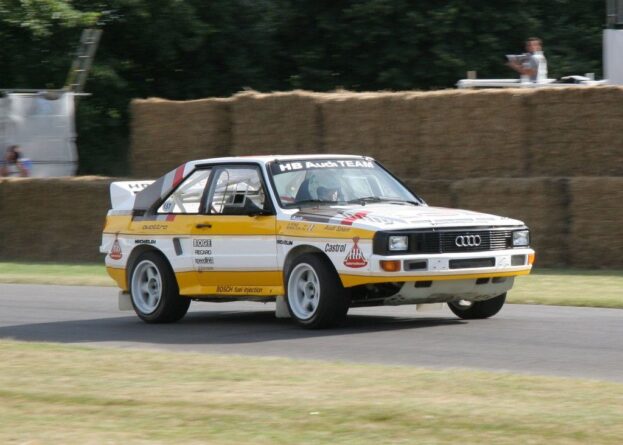
Audi’s efforts proved fruitful and the 1984 World Rally season was their most successful ever, the Sport Quattro gave Audi both the manufacturer’s title and the driver’s title with the help of legendary hoon Stig Blomqvist
While 1984 was a resounding success for Audi, it was becoming apparent that retaining the throne wouldn’t be easy in 1985. Other manufacturer’s had taken notice of Audi’s success with all-wheel-drive and began campaigning their own all-wheel-drive Group B cars. Peugeot unveiled their official Group B entry, the 205 T16, at Rally San Remo, the third to last event of the season. The 205 T16 won both the Rally San Remo and the Lombard RAC Rally, the last event of the season. Audi knew they had to juice their program to stay competitive in 1985 and they did just that
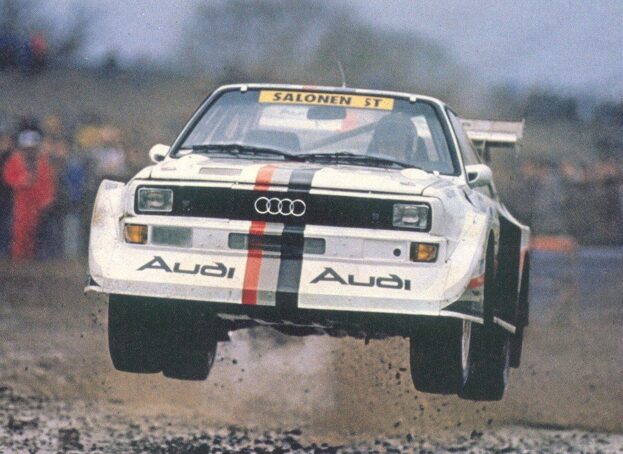
When most car freaks think of Group B rallying they think of the Audi Sport Quattro S1. With its giant wings, gaping black air intakes, and wide, aggressive stance, just looking it would make you piss yourself. It was a true beast of a car, a cheetah on steroids with a rocket on its back and all of its fur sheared off for aerodynamics
The S1 was the ultimate version of the Sport Quattro. The car received further lightening, an over the top new aero kit to provide more downforce, and a number of tweaks to the power plant including one of the first turbocharger anti-lag systems. Power now measured up to 500hp in a car that weighed only 2,403 lbs. A trip from 0-100 km/h (62mph) in the Sport Quattro S1 took 3.1 seconds. Stig Blomqvist and Walter Röhrl piloted their S1s to podium spots in the car’s first two outings. Most notably Röhrl and his S1 won the Rally San Remo by a full six seconds over Timo Salonen’s Peugeot 205 T16
But it was too late. The Sport Quattro S1 didn’t hit the stages of the 1985 Championship until the 1000 Lakes Rally, the ninth of the season’s twelve rallies. Audi campaigned the regular Sport Quattro for earlier rallies and though it took podium spots in six of those eight events, it was consistently outclassed by the Peugeot 205 T16. To make matters worse, Lancia introduced its astounding, twin-charged Delta S4 at season closer the Lombard RAC Rally and won it tidily. Audi upped the horsepower on the Sport Quattro S1 to an absurd 600+hp in 1986 in order to combat the Delta S4 and Peugeot’s still impressive 205 T16
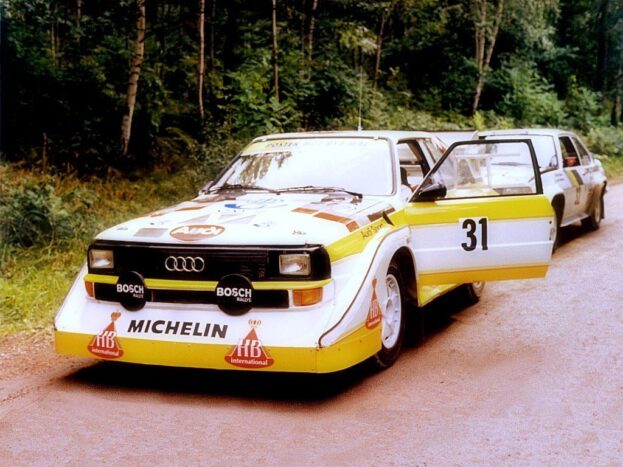
The Sport Quattro S1 earned only one podium finish in 1986, but we can’t be certain how successful the car might’ve proved as Audi pulled out of rallying mid-season along with Ford after Henri Toivonen and his co-driver Sergio Cresto suffered a fatal accident in their Lancia Delta S4 on a stage of the Tour De Course Rally. This event as well as a wreck that killed spectators at Rally Portugal and another fatal wreck the year before motivated the FIA to abolish Group B for 1987
The 600+hp 1986 Audi Sport Quattro S1 still holds the title of the most powerful rally car ever entered in international competition. Audi is certainly proud of that accomplishment, but they intended to push the limits well beyond the cuckoo’s nest. Shortly after the company pulled out of rallying in 1986 they reported that they’d been testing a version of the Sport Quattro S1 that made over 1000hp



